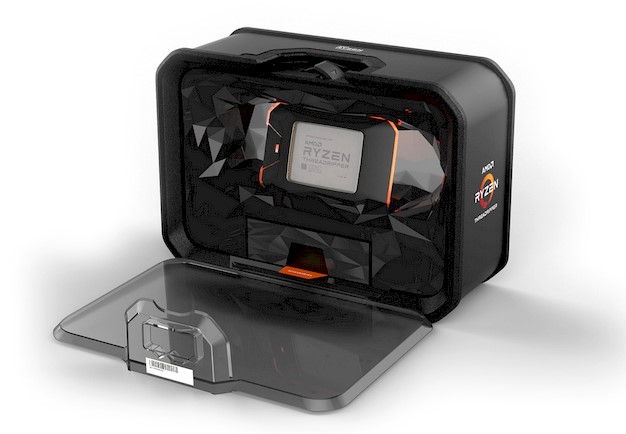AMD Ryzen Threadripper 2920X And 2970WX Review: Lower Cost, Many Core Beasts
Although they were all announced at the same time, the processors we’ll be showing you here today, the 2nd Gen Ryzen Threadripper 2970WX and Threadripper 2920X, are just now being made available. As their model numbers suggest, the 2970WX is a step down from the flagship 2990WX workstation processor and the same is true of the 2920X in relation to the 2950X. These two processors are also priced markedly lower, but they are both quite powerful as well.
Take a peek at their main features and specifications below and they we’ll dig in a little deeper, talk about some new software tricks AMD recently revealed, and see how the 2nd Gen Ryzen Threadripper 2970WX and Threadripper 2920X perform...
|
| AMD Ryzen Threadripper 2920X | AMD Ryzen Threadripper 2970WX | |
| TDP | 180W | 250W |
| Core Count | 12 Cores, 24 Threads | 24 Cores, 48 Threads |
| Core Topology | 6 Cores each, In Dies 0,1 | 6 Cores each, In Dies 0,1,2,3 |
| L2 Cache Configuration | 512K Per Core (6MB total) | 512K Per Core (12MB total) |
| L3 Cache Configuration | 16MB Per Die (32MB Total) | 16MB Per Die (64MB Total) |
| Base Frequency | 3.5GHz | 3.0GHz |
| Boost Frequency | 4.3GHz | 4.2GHz |
| PCIe Gen3 Lanes | 64 | 64 |
| Memory Channels | Quad | Quad |
| Extended Frequency Range 2 (XFR 2) | Enabled | Enabled |
| Precision Boost 2 | Enabled | Enabled |
| Transistor Count | ~9.6 Billion | ~19.2 Billion |
| Die(s) Size | 2 x 213mm2 | 4 x 213mm2 |
| AMD Suggested Pricing | $649 | $1,299 |
As we mentioned in our launch coverage, all 2nd Generation Ryzen Threadripper processors have a number of features and aspects in common. All of the processors are manufactured using the same 12nm process and feature AMD’s Zen+ microarchitecture. Although they are second generation CPUs, these processors are not based on the true, next-gen Zen 2 microarchitecture – that will be coming sometime next year.
All of the 2nd Generation Ryzen Threadripper processors feature an enhanced boost algorithm that came with Zen+ that is more opportunistic and can boost more cores, more often. They also offer higher-clocks, lower-latency, and are somewhat more tolerant of higher memory speeds, though DDR4-2933 remains the max “official” memory clock, without overclocking.
If you’d like a refresher on what makes AMD’s Ryzen processors tick, and all of the enhancements that came with Zen+, we suggest checking out a handful of past articles. Our launch coverage of the original Ryzen and Threadripper processors lays the foundation for what we’ll be showing you here today, and our coverage of AMD’s 2nd Generation Ryzen and Ryzen Threadripper processors explains what Zen+ has to offer and how all of the technology is brought together in these multi-die Threadripper processors. We are only going to cover the 2nd Gen Ryzen Threadripper 2970WX and Threadripper 2920X at a high-level here but if you want to read more about the nuts and bolts, definitely spend some time checking out our past coverage. The Threadripper 2970WX in particular (like the 2990WX) has a topology that forces some trade-offs, because two of its die don’t have any memory attached.
Before we get to the numbers, we’ve got some more 2nd Gen Threadripper specifics to get through. As you may already know, AMD selects the best processor dies for its 2nd Gen Ryzen Threadripper processors. Like the originals, only the top 5% of dies make into 2nd Gen Threadrippers, in an attempt to ensure its flagship – and most expensive -- consumer processor line-up delivers a good experience. All of the processors are also multi-chip modules that leverage multiple 8-core die, with each die consisting of two, quad-core CCXes (Compute Complexes). The 12-core 2920X has two active, 8-core dies, each with 1 core disabled per CCX, while the 24-core 2970WX has four active, 8-core dies, each with 1 core disabled per CCX.
Like the originals, AMD did some fun stuff with its 2nd Generation Ryzen Threadripper packaging. The chips come packed inside large containers made of a rigid foam, with a faceted center section and transparent windows, front and back. The container comes apart to reveal a stylized plastic case, which holds the actual processor inside. There’s also a small box tucked away at the bottom that contains a basic lit-pack, an AMD Ryzen Threadripper decal, a mini-Torque wrench (with a Torx tip) for installing the CPU into its socket, and a metal bracket, which is compatible with all Asetek-built AIO liquid coolers that have circular pump / cold plate assemblies – basically the same tool and mount bundle as the originals.












